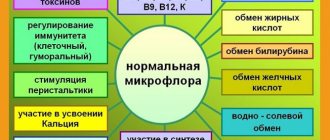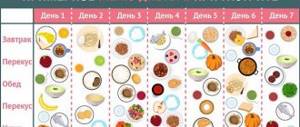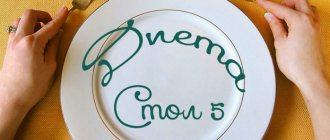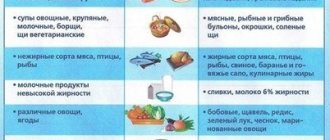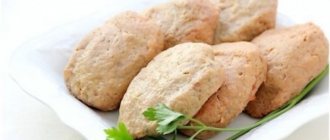Such superficial defects of the mucous membrane can be single or multiple, located in the antrum, at the fundus of the stomach or in the pylorus region, occur in acute or chronic form, be accompanied by severe symptoms or hardly bother the patient.
In any case, the presence of gastric erosion is a reason to undergo a detailed examination and comprehensive treatment, because otherwise there is a risk of increased symptoms, the development of ulcers, gastric bleeding and even tumor processes in the gastrointestinal tract.
How to eat properly with erosive gastritis of the stomach
Contents
Erosions are open wounds of the inner lining of the stomach within the mucous membrane. Obviously, if spicy, hard-to-digest food comes into contact with them, they will become inflamed and may even begin to bleed, aggravating the patient’s well-being and provoking increased pain.
It is very important to follow a diet and eat properly for this pathology. None of the most expensive and effective medications can help if you do not follow a diet for erosive processes in the mucous membrane.
Treatment and diet for erosive gastritis in the acute stage
In case of acute gastritis or exacerbation of a chronic disease, you should try to protect the gastric mucosa as much as possible from mechanical, thermal, and chemical trauma. You should adhere to the following nutritional rules:
- In the first two to three days of an exacerbation, take food in liquid and semi-liquid form, gradually, as the general condition improves, the patient is transferred to diet No. 1, which includes boiled food, but no longer pureed.
Today, gastroenterologists are of the opinion that long-term consumption of only semi-liquid products does not accelerate the healing process of erosions. It is necessary to gradually include fiber, stale bread, and boiled vegetables in the diet.
These products stimulate mucosal repair processes, prevent the development of constipation, restore appetite and have a positive effect on the patient’s overall well-being.
- You need to eat food often (5-6 times a day), but in small portions
- The diet should be complete and balanced in essential nutrients. It is recommended to consume proteins - 110-120 g, fats - 110-120 g, carbohydrates - 400-450 g
- Culinary processing is allowed - stewing, boiling, baking in the oven in its own juice. You cannot fry food, marinate, or cook with the addition of pork fat or butter.
- Food should be warm; eating scalding or icy foods is not permissible. Thermal trauma to the mucous membrane is excluded
- It is important to eat food slowly, sitting, chewing it thoroughly. It is advisable to avoid talking during meals and laughing, since excessive swallowing of air in the gastrointestinal tract can lead to increased gas formation, interferes with digestion and makes it difficult to absorb nutrients.
In modern gastroenterology, there has been a certain departure from mandatory adherence to unshakable dietary recommendations among patients with erosive lesions of the gastrointestinal tract.
It is impossible to completely neglect therapeutic nutrition, but it hardly makes sense to complicate the patient’s life with too strict dietary prescriptions, such as those put forward earlier.
For example, bring all food consumed to a mucus-like, jelly-like state. Such nutrition is recommended only in the first days of an exacerbation, or in case of complications of erosion.
You should not overeat at night, overload your stomach with large amounts of food, or eat foods that irritate the gastric mucosa and stimulate the production of hydrochloric acid.
You need to understand which foods you can say “yes” to, and which foods you can say a firm “no”. Compliance with these simple rules in combination with drug treatment will allow the stomach to recover faster and the patient to feel healthy.
A resounding “yes” should be said to the following foods:
- Mucous or milky (if milk tolerance is good) soups made from buckwheat, semolina, oatmeal, bran
- Soft-boiled eggs
- Meat soufflé
- Boiled meat and fish
- Moderate amount of milk
- White bread
- Dry liver
- Boiled vegetables
- Pasta
- Boiled or stewed vegetables
- Kiselyam
- Jelly
- Weak tea
Such food has buffering properties, does not cause excessive formation of HCl, does not irritate the inner wall of the gastrointestinal tract, and helps accelerate the healing of erosions.
In 100% of cases, the patient, having switched to food that is more delicate both in composition and in terms of culinary processing, will feel an improvement in overall well-being and lightness in the body.
A firm “no”, regardless of whether the patient has an exacerbation or remission of gastritis, should be said to the following products:
- Meat, fish and mushroom decoctions
- Fried food
- Peppered, salty, spicy foods
- Smoked meats and canned goods
- Seasonings and spices (mustard, onion, garlic, pepper)
- Pickles and marinades
- Fast food
- Soda
- Sour juices
- Strong coffee and tea
- Alcohol
By consuming anything from the prohibited list for erosive gastritis, there is a risk of irritation of the mucous membrane, increased defects in the inner gastric lining, increased acidity and excessive production of HCl, which leads to a deterioration in health and contributes to the transition of erosions to ulcers.
Nutrition rules
A diet for gastric erosion is a balanced diet that allows you to restore the affected mucous membrane in a short time. Before talking about what you should and can eat, you should look at the foods that are recommended to be excluded.
Nutrition for this type of pathology excludes all products that can mechanically injure the stomach. You should not eat too hard foods, for example, dry foods (sandwiches, crackers, cookies), hard varieties of vegetables and fruits. Food must be chewed thoroughly so that it enters the stomach in a partially processed form. This is especially necessary for erosive and ulcerative processes. In this case, it is not possible to digest complex foods on your own. This provokes stagnation of food in one of the sections of the gastrointestinal tract, poor absorption of nutrients and fermentation processes.
All components of the diet should be soft, and it is better to eat food pureed. Strong coffee and alcohol should be avoided. The first drink stimulates the production of acids, which increases the destruction of the already damaged mucous membrane. Alcohol acts even more aggressively and can provoke the transition of erosion into an ulcer in the shortest possible time. Wine, beer, cocktails and other drinks with low alcohol content are especially dangerous.
You should exclude vegetables and fruits, which take a long time to digest and stimulate increased secretion. These include:
- radish;
- onion;
- garlic;
- eggplant;
- tomatoes;
- pumpkin;
- cabbage;
- apples;
- citrus;
- grape;
- plum
It is necessary to exclude all sour varieties of fruits and berries during treatment. It is not recommended to consume chocolate, cakes, pastries and all types of pastries. Contraindicated are semi-finished products, strong meat broths, fatty and fried foods, smoked sausages, sausage and chicken. Kebabs and other grilled dishes (especially meat) are also not recommended.
All carbonated drinks, including mineral water, are excluded. It is not recommended to chew gum, especially on an empty stomach. This process stimulates the production of acids for digestion. As a result, food does not arrive, and gastric juice begins to damage the walls of the organ.
What fruits can you eat with erosive gastritis of the stomach?
As a rule, this pathology occurs with increased acidity, and patients intuitively avoid all sour fruits, saying that they do not want to eat them.
And this is absolutely true: any sour fruit, as well as juices from them (both freshly squeezed and canned) negatively affect the inner gastric lining.
Oranges, lemons, sour apples, fresh berries, tangerines, pomegranates, grapes, early watermelons and melons from the market (usually they contain a large amount of nitrates).
Allowed for consumption during the remission stage: bananas, sweet varieties of apples (without skin), preferably baked, pears in moderation.
Apples contain a large amount of pectin, and are especially useful for patients with erosions during heat treatment - baking.
Bananas are also a neutral dessert and are well tolerated by patients if consumed in moderation: 1-2 bananas per week.
You can cook jelly from fresh berries and starch during the attenuation stage of the disease. Starch is an excellent enveloping agent that neutralizes the effects of acids found in berries.
In addition, their heat treatment also leads to a decrease in irritating effects on the stomach.
Erosive antral gastritis. Diet
In the first days, it is necessary to cleanse the body, so you need to fast for 1-2 days. At this time, you can have weak black tea or mineral water. Then you need to eat food often, but in small portions, boiled and pureed. For example, various cereals, vegetable purees, chopped meat. The ban applies to foods that are difficult to digest and linger for a long time. Take food warm.
It is necessary to take antibiotics with food.
Do not forget about traditional medicine. Among these recipes one can highlight, for example, potato juice (freshly squeezed), cabbage juice, tinctures of burdock and plantain roots and much more.
Nutrition for erosive reflux gastritis
It happens that the pathology is combined with reflux - the backflow of stomach contents into the esophagus due to weakness of the cardiac sphincter.
In this case, the list of permitted and prohibited products remains the same, but there are some additions for patients suffering from esophageal reflux in combination with gastric erosions:
- Do not under any circumstances overeat! Any overstretching of the stomach walls with food leads to increased backflow of food and worsening well-being. The rule fits perfectly: you should get up from the table after eating hungry. It should be remembered that the true feeling of fullness comes 30-40 minutes after eating.
- Do not take a horizontal position after eating. You should spend 2 hours in a sitting position. You should also not bend over.
- Do not wear a belt that is too tight or restricts clothing in the abdominal area.
- Don't eat at night. The last meal should be taken 2.5-3 hours before bedtime.
- Portions should not be large. In nutrition, you should adhere to the rule “better less, but more often.”
- Do not immediately wash down what you eat with a mug of tea or water. You should pause between meals and drinks for at least 40-60 minutes. “first, second and compote” will lead to inevitable overeating. You can eat the first one and drink compote 40 minutes later. And after 2 hours he will use the second one. Of course, from the approved list of products.
Following simple nutritional rules will lead to an improvement in the patient’s well-being.
Additional nutrition rules
Meals for erosion of the gastric mucosa should be at least 4 times a day. In this case, 2 hours before bedtime you should drink milk, jelly or whey. Under no circumstances should you take long breaks between meals and endure painful symptoms, much less snack on dry food.
If you can’t eat and 3 hours have already passed after eating, then you can snack on a sweet banana. It has excellent astringent properties and will help temporarily relieve hunger. However, this can only be done as an exception. You need to eat food strictly at the same time for at least a month.
It is better that proper nutrition becomes a habit. The temperature regime must also be observed. Avoid eating too hot or cold foods. Ice cream should be completely excluded. The temperature of the food should be medium, comfortable for the mouth, not scalding or cold.
All products should preferably be boiled, stewed and baked before consumption. Frying in oil is strictly prohibited. First courses can only be prepared without frying. The basis for the broth should be vegetables, lean meat and fish.
As for baked goods, fresh bread is prohibited. You can use soaked crackers. Yesterday bread or oven-dried bread is allowed. If you have stomach erosion, you should eat honey with caution. It is better to give preference to soft varieties. It is very useful to mix this beekeeping product with milk. Honey stimulates secretion, so you can’t consume it on an empty stomach, but combining it with other foods is even useful.
When consumed correctly, honey will help restore the mucous membrane faster. Moreover, it is better to combine it with tea and crackers. Warm milk with this bee product can be consumed before bed. This will calm your stomach and help you sleep better. Honey should not be dissolved in hot drinks, only in warm ones. If you neglect this rule, then such a product may cause harm rather than benefit. Before including honey in your diet, you should consult your doctor.
Diet in remission
The prohibited list described above also works in case of remission of the pathology. Any violation of it and the consumption of foods harmful to the stomach can provoke an exacerbation and the formation of new erosive defects.
In remission, steamed cutlets, meatballs, boiled sausage, omelettes, soft-boiled eggs, rye bread, butter and vegetable oil, cottage cheese, yogurt, yogurt, crackers, stale bread, boiled vegetables are allowed.
Transferring a disease to a state of attenuation or remission does not mean complete health. And any error in the diet can provoke a return of the disease, and even aggravate the previous clinical condition during exacerbation.
Diet therapy in terms of treatment
One of the first non-drug treatment methods that should be adopted after diagnosis is nutritional therapy for erosive gastritis. What rules is it based on?
The principles of the diet for acute erosive inflammation of stomach tissue are based on reducing the load on the gastrointestinal tract and reducing inflammation.
On the first day of an exacerbation, gastroenterologists recommend giving up food completely. Then semi-liquid and well-cooked porridge, jelly, and boiled eggs are gradually introduced into the diet.
As the acute process is relieved, the menu expands and may contain all permitted products (see the section below).
General principles of nutrition during remission of the disease include:
- Small meals 5-6 times a day.
- Small portions of even healthy foods.
- Drink 1-2 glasses of still water at room temperature daily in the morning on an empty stomach.
- The preferred methods of heat treatment of food are boiling and steaming.
- Fried, smoked and pickled foods are contraindicated.
It is recommended for patients with erosive gastritis to follow a gentle diet throughout their lives.
Many patients have a hard time with dietary restrictions and want to quickly get rid of unpleasant symptoms. To speed up the restoration of the mucous membrane and normalize the acid-forming function, it is recommended to include certain dishes in the diet. Gastroenterologists recommend the following list of the best foods for gastritis:
- Oatmeal porridge - a liquid, viscous consistency envelops the gastric mucosa, reduces inflammation and pain, especially in erosive conditions. To improve its taste, you can cook it with milk and add various fruits.
- Puree soups - made from cereals with the addition of vegetables and vegetable oil, stimulate the digestive process and improve appetite.
- Low-fat fish - hake, pike perch, pollock - are a source of polyunsaturated fatty acids and protein and have antioxidant properties.
- Vegetable drinks - potato, pumpkin juice have regenerative abilities, eliminate cramps in the stomach, normalize the secretion of gastric juice.
- Yogurt - restores the epithelium of the stomach, reduces pain, is a prebiotic, improves the digestive process.
Dietary nutrition for such a disease depends on what form the patient suffers from.
Thus, for acute erosive gastritis, dietary table No. 1 is prescribed. This special diet limits the consumption of foods that can stimulate secretion, as well as foods that irritate the gastric mucosa.
The amount of food consumed per day must be divided into several meals. The most correct thing would be to divide it into 6 meals, i.e. approximately eat every 2 hours.
Food for erosive gastritis must be prepared by stewing or boiling. Steaming is also acceptable. Some doctors allow baking, but a hard crust should be avoided.
During exacerbation of erosive gastritis, the diet must be strictly followed in order to reduce foci of inflammation, speed up healing, and normalize the functioning of the stomach.
Don't forget about liquid! It must be consumed in the amount of 1.5 liters per day. But this includes drinks and soups.
Diet and menu for a week for erosive gastritis of the stomach - how to eat and what you can eat
An approximate menu of products that can be consumed for this pathology.
Monday
- Breakfast (8.00) - 1 soft-boiled egg, a slice of white bread, 150 g low-fat cottage cheese, weak tea without sugar
- Second breakfast (12.00) – 100 g unsweetened yogurt
- Lunch (15.00) – soup with boiled vegetables, jelly
- Afternoon snack (17.00) – dry cookies, 200 g yogurt
- Dinner (19.00) – Boiled meatballs 120 g, pasta, weak tea
Tuesday
- Breakfast (8.00) – slimy oatmeal with a piece of butter on water, weak tea
- Second breakfast (12.00) – biscuits, glass of milk
- Lunch (15.00) – pureed vegetable soup, boiled chicken 80 g
- Afternoon snack (17.00) – 1 medium banana
- Dinner (19.00) – buckwheat, boiled “doctor’s” sausage – 100 g, jelly
Wednesday
- Breakfast (8.00) – low-fat cottage cheese with sour cream – 150 g, cocoa or weak tea
- Second breakfast (12.00) – yogurt
- Lunch (15.00) – low-fat soup with meatballs, a slice of loaf with butter 10 g, rosehip decoction – 100 g
- Afternoon snack (17.00) – medium-sized baked apple
- Dinner (19.00) – boiled beef 120 g, boiled vegetables
Thursday
- Breakfast (8.00) – oatmeal, weak tea
- Second breakfast (12.00) – sour cream jelly – 150 g
- Lunch (15.00) – mashed potatoes, lean ham 100 g, rose hip broth
- Afternoon snack (17.00) – pudding – 150g
- Dinner (19.00) – boiled fish 150 g, loose buckwheat porridge, weak tea
Friday
- Breakfast (8.00) – omelette – 200 g, weak tea
- Second breakfast (12.00) – glass of milk, biscuits
- Lunch (15.00) - soup with boiled vegetables, jelly
- Afternoon snack (17.00) – stale bun, weak tea
- Dinner (19.00) – cottage cheese pancakes, rosehip broth
Saturday
- Breakfast (8.00) - low-fat cottage cheese with sour cream - 150 g, cocoa or weak tea
- Second breakfast (12.00) – yogurt
- Lunch (15.00) – mashed potatoes, lean ham 100 g, rose hip broth
- Afternoon snack (17.00) – dry biscuits, 200g yogurt
- Dinner (19.00) – Boiled meatballs 120 g, pasta, weak tea
Sunday
- Breakfast (8.00) – slimy oatmeal with water, weak tea
- Second breakfast (12.00) – crackers, glass of milk
- Lunch (15.00) – low-fat soup without seasoning with meatballs, a slice of loaf with butter 10 g, rose hip decoction – 100 g
- Afternoon snack (17.00) – medium-sized baked apple
- Dinner (19.00) – boiled fish 150 g, loose buckwheat porridge, weak tea
It is recommended to eat food at the same time; between meals you are allowed to drink still water if desired.
Compliance with therapeutic nutrition and simple rules will avoid exacerbation of erosive processes in the stomach, and in combination with drug treatment, will lead to the healing of mucosal defects and restoration of its normal structure.
bolvzheludke.ru
Recommended and prohibited products
The patient's diet must include all the substances necessary to ensure normal functioning.
At the same time, you need to eat dishes that do not irritate the mucous membrane and do not cause an increase in the acidity of gastric juice.
A nutritionist develops a weekly menu for stomach erosions, which includes the following products:
- overcooked cereals cooked until gluten appears;
- steam omelettes and boiled eggs;
- vegetable broth, puree soups;
- dishes made from minced meat and low-fat steamed fish;
- be sure to drink jelly;
- pureed vegetables seasoned with refined vegetable oil;
- fresh dairy products, low-fat kefir;
- yesterday's bread, biscuits;
- bananas, baked apples;
- fruits, crushed to puree;
- pasta made from durum wheat.
Bananas for gastric erosion should be eaten only when the patient has stable stools and does not experience flatulence.
Useful substances such as potassium, magnesium, vitamins B and C help improve the digestion process and recovery from vomiting. In addition, bananas contain fiber, which stimulates the stomach.
However, people with reduced activity should consume bananas with caution. When bananas linger in the stomach, they cause a fermentation process, which is accompanied by the formation of gases.
In order to avoid unpleasant consequences, it is necessary to maintain time between eating the fruit and the main meal.
The diet prescribed by a gastroenterologist together with a nutritionist for gastric erosion involves a complete rejection of the following products:
- fast food, fatty foods high in carbohydrates;
- fried, smoked, spicy foods;
- sour berries, hard-skinned fruits;
- fatty kefir, cottage cheese and other fermented milk products;
- vegetables that stimulate the process of gas formation, such as legumes, corn, radishes, etc.;
- alcohol-containing drinks, carbonated drinks, coffee, strong tea.
Patients should not eat confectionery, pastries made from butter or puff pastry, or chocolate.
The periodic desire to “pamper” yourself with excesses can lead to a deterioration in health, therefore, in case of stomach erosion, the diet must be followed very strictly.
The weekly menu compiled by a nutritionist contains all the necessary nutrients.
What is gastric erosion?
The course of the disease is not clear and requires an individual doctor’s approach to each case. Effective treatment of erosive gastritis is possible with an accurate determination of the cause and type of disease, which play a decisive role in drawing up therapeutic regimens:
- primary erosion - organ pathology;
- secondary erosion is a background disease;
- malignant erosion - due to diagnosed Crohn's disease or cancer.
Erosive gastritis occurs when acids produced by the cells of the stomach lining tissue destroy the inner surface of the organ. In a healthy person, the epithelial layer is able to withstand the action of acids, but when the protective layer is broken, the smooth muscles are damaged - the acid acts destructively.
It is worth noting that the appearance of erosion is not always detected in a timely manner, since in some cases the disease does not manifest itself as bothersome symptoms.
According to the classification, gastric erosion occurs:
- Acute - the pathological area is located at the bottom or in the body of the stomach.
- Chronic - with localization of the focus in the antrum - erosive antral gastritis.
- Complete - grows in the pyloric region and is visually distinguished by the formation of convex areas with a heterogeneous structure.
- Hemorrhagic - the pathology is dangerous, as it can provoke internal bleeding.
The first symptoms and signs of discomfort are a reason to seek advice from a gastroenterologist.
Diet for damage to the antrum of the stomach
This form of pathology is a type of reflux gastritis, only erosive formations are recorded exclusively in the antrum of the stomach. It is necessary to completely exclude fatty meats and foods with a sour taste, including fermented milk, from the patient’s diet.
During the period of exacerbation, split meals are recommended - at least 6 times a day. It is advisable to take food lying down, in small portions
The menu for gastric erosion of this form should completely exclude alcoholic drinks of any strength, coffee, spicy and rough foods, smoked foods, fried foods, and fatty foods. Industrial semi-finished products, salt, spices, sweets, baked goods, onions, garlic, mustard, horseradish sauces, ketchup, and mayonnaise are also prohibited. The diet helps normalize the production of digestive enzymes and also stimulates the healing of ulcerations.
Causes of gastric erosion
Treatment of gastric erosion is effective only if the negative factor that provoked the pathology is eliminated. Therapy is quite complex, since the disease is not fully understood. One version says that, for various reasons, the mucous tissue does not receive oxygen in sufficient quantities, which contributes to the development of dysfunction and oxygen starvation - the permeability of cell membranes is impaired, and accordingly, vital metabolic processes are not fully carried out.
Pathological areas activate the body's immune response - leukocytes actively produce hydrochloric acid and digestive pepsin, which, against the background of a genetic predisposition, triggers chronic processes and leads to disruption of autoimmune cells.
The cause of erosion is not always the aggressive action of gastric juice. In some cases, pathological areas appear due to the suppressed regenerative function of the epithelium.
Many years of practice of gastroenterologists and scientific research give us the right to assume that the following potential patients are included in the risk group, which unites people prone to the disease:
- survivors of trauma, shock, sepsis, burns;
- patients after surgery on the digestive organs;
- those who are in a prolonged state of stress, psycho-emotional shocks;
- smokers and people who abuse alcohol;
- those undergoing long-term NSAID therapy;
- those who have suffered tissue burns from excessively hot food or alcohol-containing drinks;
- after intoxication with heavy metal salts;
- people diagnosed with pancreatitis, cholecystitis;
- those suffering from diseases of the respiratory system with hypoxia and suppressed barrier functions;
- patients diagnosed with cancer of the stomach and digestive organs.
The primary task of doctors is to exclude the destructive effects of Helicobacter pylori.
Also, leading experts study the medical history in detail, since gastric erosion often appears against the background of neoplasms of any nature, as a result of inflammation in the intestines, liver, lungs, as well as blood and heart diseases.
Erosive gastritis of the stomach is often a consequence of thrombosis and congestion in the portal vein.
It is worth noting that the causes of the appearance of a pathological process can be several factors at the same time:
Causes of gastric erosion
| CAUSES | Frequency of cases in % |
| Acetylsalicylic acid | 36 |
| Complications after surgery | 16 |
| The effect of alcohol on the body | 8 |
| Infections | 4 |
| Medications | 2, 5 |
| Phenylbutazone | 5 |
| Steroid drugs | 1, 5 |
| Anticoagulants | 1, 5 |
| Renal dysfunction | 1, 5 |
Symptoms of erosive gastritis
The onset of the disease is usually ignored and the occasional signs of discomfort are not given importance. The enlargement of the lesion, the formation of multiple wounds, significantly affects the general condition. Few people know that the diagnosis of gastric erosion is indicated by the following symptoms:
- attacks of nausea and prolonged vomiting;
- belching with a taste of acid, heartburn;
- severe epigastric pain due to gastric erosion, after eating;
- internal bleeding;
- inclusion of blood clots in the stool;
- decreased hemoglobin, anemia;
- excessive fragility of the nail plate;
- loss of strength, weakness;
- diarrhea or constipation;
- violation of the outflow of bile;
- changes in blood pressure.
Any symptom of gastric erosion cannot be ignored. Early diagnosis increases the chance of a quick recovery.
Etiology, symptoms and diagnosis of pathology
The gastric mucosa is usually protected from the aggressive effects of gastric juice.
However, when the acidity of the mucus increases or due to the ingress of pathogenic microorganisms into it, ulcers form on the surface of the mucous membrane of the antrum of the stomach, located randomly or in a certain order.
A characteristic difference between erosion and peptic ulcer is that with a well-designed treatment regimen, erosion heals without leaving any traces.
Only the mucous membrane of the organ is affected; deeper tissues are not involved in the process.
Gastroenterologists call the main causes of gastric erosion:
- Taking medications that destroy mucous membranes. These include anti-tuberculosis drugs, some heart medications and painkillers.
- Previous operations or injuries to the digestive organs.
- Eating too hot, hot, spicy, smoked foods. Fatty dishes and rough foods also negatively affect the integrity of the mucous membrane.
- Burns from hot smoke during smoking and excessive consumption of alcoholic beverages not only weaken the body, but can also cause erosion.
- Poisoning with chemicals, working in hazardous conditions.
- Chronic pathologies such as heart failure, liver disorders, diabetes mellitus.
- Oncological diseases can be both a cause and a consequence of gastric erosion.
In the initial stages, the pathology may be asymptomatic. However, the appearance of the first signs similar to heartburn or peptic ulcers requires immediate consultation with a doctor, as they may indicate the development of a more serious disease.
The main symptoms of gastric erosion are:
- abdominal pain of varying intensity, both hungry and after eating;
- nausea, belching, constipation;
- frequent vomiting can be confused with a symptom of intoxication, however, the appearance of blood in the vomit or stool is a reason to immediately visit a gastroenterologist;
- increased fragility of the nail plate, dryness and hair loss are observed against the background of anemia resulting from internal bleeding;
- Chronic gastric erosion is accompanied by weight loss.
Diagnostic measures include patient interview, laboratory tests and endoscopy.
If the diagnosis is confirmed, the doctor prescribes an individual treatment regimen, which includes taking antibiotics, drugs to restore the mucous membrane, physiotherapy and diet therapy.
How to eat properly with erosive gastritis
The diet for erosion may be slightly different, since the restrictions in the acute form are stricter than in the chronic form. The composition of the food basket can also be affected by acidity. It is worth noting that the general nutritional requirements for pathological changes in organs are not violated. Food should be well digested and not irritating. What can you eat if you have stomach erosion, says the gastroenterologist, immediately after the diagnosis is made.
Nutrition for acute erosive gastritis
Acute erosive gastritis is accompanied by pronounced symptoms and in this condition it is necessary to refuse any food at all. At this stage, the digestive organs need rest. If the exacerbation is stimulated by the actions of toxins, then most likely you should additionally rinse the stomach.
If acute gastric erosion is diagnosed, it is better to drink only warm water for the first days. Usually the doctor immediately provides a list of permitted foods. You can drink tea for stomach erosion with a weak concentration of tea leaves. After relief occurs, they switch to eating soft, crushed food. The following products are gradually introduced for erosive gastritis:
- not concentrated tea;
- decoction of medicinal herbs, jelly;
- honey.
Juices for acute erosive gastritis should not be consumed - they have an irritating effect on mucous tissues.
What should you not eat if you have acute erosive gastritis?
- vegetables, fruits;
- strong broths;
- lactic acid products;
- caffeine containing drinks;
- chocolate;
- buns;
- hard, sharp cheeses.
Cooking processes are selected that are gentle. When choosing dishes, follow the tips for following diet No. 1.
Nutrition for erosive gastritis in chronic form
For chronic gastric erosion, diet No. 2 is prescribed. It is softer and requires moderate restrictions. The following are excluded from the food basket:
- baking;
- soups with legumes;
- fatty meat and fish;
- pickles, smoked meats, preservation;
- pickled, non-heat-treated vegetables;
- garlic, onion, radish;
- mushrooms;
- fruits of rough varieties without prior preparation;
- chocolate.
For chronic erosive gastritis the following is allowed:
- bread is not the first freshness, mostly wheat;
- soups with light broth;
- meat, fish without fat;
- cream, fermented milk products;
- porridge;
- carrots, potatoes, zucchini, beets, cabbage;
- fruits are juicy, soft, sweet;
- healthy sweets.
For the diet to be effective, some habits should be reconsidered. To the question, can you drink alcohol if you have stomach erosion? The answer is clear: it is detrimental to the digestive system with pathological changes. Alcohol during gastric erosion has an aggressive effect on the walls of the mucous tissue and causes intoxication.
Authorized Products
Diet for erosion of the stomach and duodenum includes:
- Vegetable soups with the addition of oatmeal, buckwheat, rice cereals, which are thoroughly pureed, and when the condition improves - with well-cooked and mashed cereals and finely chopped vegetables. To improve the taste, butter, low-fat cream, egg-milk mixture, meat puree, and non-garden herbs (dill or parsley) are added to first courses.
- Low-fat varieties of red meat and poultry (beef, young lamb, lean pork, turkey, chicken), rabbit in the form of steam cutlets, meatballs, zraz, quenelles, soufflé. When the process subsides, lump meat, boiled/baked in the oven, is introduced into the diet.
- River/sea fish in the form of quenelles, cutlets, meatballs of cod, pollock, pike, hake, ice fish.
- Dried bread made from premium wheat flour, crackers, savory buns.
- Cereals: oatmeal, buckwheat, mashed/well-cooked white rice with milk and butter.
- Mild homemade sauces made with milk/low-fat cream.
- Fresh non-sour cottage cheese, lazy dumplings, cottage cheese soufflé, baked cheesecakes, milk jelly. Cream and sour cream are added to ready-made soups and mashed potatoes. Milk is allowed to be consumed in quantities of no more than 800 ml.
- Soft-boiled eggs/steam omelet (2-3 pieces), added to soups and other dishes. Butter up to 20 g/day and refined vegetable oil as additives to ready-made first and second courses.
- Cooked berries (jelly, jelly, mousse). Apples baked in the oven with honey/sugar. Cannot be consumed fresh. For dessert - honey, caramel, meringues, marshmallows, meringue, jam, marshmallow.
- Free liquid of at least 1.5 l/day in the form of a decoction of wheat bran, freshly prepared diluted juices from berries/fruits, weak tea with milk, rosehip infusion, carrot juice, non-carbonated mineral water.
Abuse of fatty, fried and spicy foods leads to the formation of ulcers on the mucous membrane, which, if left untreated, can cause the development of oncology, therefore a diet for gastric erosion and appropriate drug treatment play a big role in the patient’s recovery process.
The symptoms of the pathology may be similar to those of a peptic ulcer, however, if you follow the recommendations of the attending physician, damage to the mucous membrane can be completely cured.
Prevention plays an important role, which consists of creating a diet that will facilitate the restoration of the mucous membrane.
Menu for gastric erosion for a week
Menu for erosive gastritis
| DAYS OF THE WEEK | APPROACHES TO EATING | ACCEPTABLE PRODUCTS FOR STOMACH EROSION |
| Monday | Breakfast | Boiled eggs, stale bread, oatmeal, apple-rosehip infusion |
| Lunch | Biscuit, dried compote | |
| Dinner | Buckwheat soup, pureed pumpkin, meatballs, tea with milk | |
| Afternoon snack | Milk (200 ml), dried bread | |
| Dinner | Pasta with beef chops, salad with cream | |
| Before sleep | Ryazhenka (200 ml) | |
| Tuesday | Breakfast | Buckwheat, milk soufflé, tea |
| Lunch | Oatmeal broth (200 ml) | |
| Dinner | Beef meatball soup and spaghetti, carrots, peas | |
| Afternoon snack | Fermented milk cheese | |
| Dinner | Casserole of seasonal vegetables, chops, herbal tea with honey | |
| Before sleep | Fruit jelly (200 ml) | |
| Wednesday | Breakfast | Fermented milk cheese, honey, bread, dried compote |
| Lunch | Milk | |
| Dinner | Mashed potato soup, vegetable casserole, turkey meat, dried compote | |
| Afternoon snack | Milk soufflé with fruits | |
| Dinner | Rice, veal, carrots, peas, milk tea | |
| Before sleep | Cocoa, oat cookies | |
| Thursday | Breakfast | Oatmeal, fish, milk tea |
| Lunch | Milk jelly | |
| Dinner | Soup (chicken, vegetables), mashed potatoes, meatballs, milk cocoa | |
| Afternoon snack | Fermented milk cheese | |
| Dinner | Meatballs, boiled peas, dried bread, dried compote | |
| Before sleep | Kefir | |
| Friday | Breakfast | Soft-boiled egg, stale bread, oatmeal, cocoa |
| Lunch | Decoction (oats) | |
| Dinner | Pea soup, fish, baked pumpkin | |
| Afternoon snack | Milk jelly | |
| Dinner | Casserole of seasonal vegetables, fish, rosehip infusion | |
| Before sleep | Oat cookies, kefir | |
| Saturday | Breakfast | Apples stuffed with sour-milk cheese and raisins, toasted bread, juice |
| Lunch | Kefir | |
| Dinner | Soup (chicken, vegetables), carrot-potato puree, meatballs, cocoa | |
| Afternoon snack | Fermented milk cheese, honey | |
| Dinner | Pasta with chicken, baked pumpkin, cocoa | |
| Before sleep | Kissel with fruits (200 ml) | |
| Sunday | Breakfast | Buckwheat porridge, milk soufflé, tea |
| Lunch | Baked fruits, low fat milk | |
| Dinner | Cabbage soup, meatballs, rice, cocoa | |
| Afternoon snack | Vegetable casserole, tea | |
| Dinner | Fish, carrots, peas, vegetables with cream, rosehip infusion | |
| Before sleep | Kefir |
Sample menu
Let's look at a diet for erosive gastritis of the stomach, a menu that contains all the necessary and preferred dishes. In this case, the diet for erosive gastritis - a sample menu - does not include a schedule by day of the week. Each meal offers several acceptable options:
- Breakfast. To choose from: oatmeal, steam omelette, cottage cheese and berry omelette, boiled eggs, lazy dumplings, rice pudding. Drinks: weak tea with crackers, chamomile tea, compote.
- Snack. Some fruit, or a handful of dried fruits, or a fruit soufflé.
- Dinner . Vegetable soup, cereal soup, beetroot soup - to choose from. Steam cutlets, steamed fish balls, vegetables and chicken fillet, fish and vegetable casserole - to choose from. Weak tea, compote or rosehip decoction.
- Afternoon snack. Berry and fruit mousses, souffle, or baked apple, or low-fat cottage cheese, or a handful of dried fruits, or biscuits with compote.
- Dinner. Meat stew, slaves and potatoes from a steamer, boiled buckwheat with liver, vegetarian pilaf and crackers, boiled fish with vegetables - your choice. Drinks include herbal or weak tea.
- For the night. Low-fat kefir, or tea with milk, or yogurt.
What is allowed for gastric erosion?
Butter is not used for stomach erosion. It is not recommended to cook broths on any basis to be saturated.
The meat chosen is dietary, and from the variety of fish, it is better to opt for hake, pike perch, flounder, cod, and pollock.
Is it possible to eat bread if you have stomach erosion? Doctors do not recommend consuming baked goods, as they cause fermentation. If it is not possible to refuse completely, you can treat yourself to toast or a dried slice.
Porridge for stomach erosion is a useful product for the full function of the digestive organs; they are rich in vitamins and minerals. It is recommended to include oatmeal or buckwheat, rice and others in your diet every day, except those prohibited. Fruits should dominate the grocery basket of every consumer.
Fruits for stomach erosion:
The fruits are consumed when ripe, not overripe.
Dairy products are useful, but when erosion occurs, whole milk is eliminated from the diet, and cottage cheese is more valuable in the form of casseroles.
Tea and chicory should not be drunk hot. All drinks should be pleasantly warm. Strong, carbonated drinks with signs of fermentation should be discarded.
Nuts are rich in vitamins and healthy fats and should definitely be included in your diet. In order not to overload the damaged organ, the total daily amount should not be more than 20 g, if we are talking about cashews - 5 g.
Diet for gastric erosion is an important measure that promotes rapid tissue restoration and smoothes out bothersome symptoms.
Recommended Recipes
When faced with dietary nutrition, many patients ask the question, what technologies are best to use when preparing?
Experts recommend using a double boiler or the corresponding multicooker function.
If there is no special equipment at home, the dishes are boiled in a saucepan. Fruits, including bananas, are peeled and thoroughly chopped in a blender. Cooking recipes can be found on the Internet.
- The diet involves eating a variety of vegetable purees. To prepare them, the vegetable is washed, peeled and cut into large pieces, which are placed in cold, slightly salted water and put on fire. After boiling, leave for 10 minutes, after which the vegetables are taken out, blended with a blender and poured with vegetable broth to the required consistency. You can add a large spoonful of low-fat cream to the soup. In order to diversify the menu for the week, vegetables can be combined depending on taste.
- Nutrition for gastric erosion requires the consumption of large quantities of milk soups and cereals. Recipes differ in the amount of cereal added. As a rule, milk and water are taken as a basis in equal parts. After boiling, add semolina, oatmeal, etc. to the resulting mixture. A special diet, which requires erosion of the gastric mucosa, allows you to add a little butter to the porridge or add a raw egg.
- Special nutrition involves eating eggs. It can be boiled to varying degrees of doneness. The diet allows for the preparation of steamed omelettes or egg-milk soups. To do this, pour beaten eggs into cold milk, and leave the resulting mixture on low heat until cooked.
- In case of stomach erosion, it is necessary to consume fish and lean meat. Since all food should be served in pureed form, steamed cutlets and meatballs are prepared from the products. The fillet is thoroughly chopped, the beaten egg white and a little butter are carefully added, dumplings are formed and boiled in salted water.
The diet prescribed after a comprehensive examination of gastric erosion is prescribed in parallel with drug therapy and involves the use of dishes containing foods that do not irritate the mucous membrane and help reduce acidity.
Such a diet will help not only restore the organs of the gastrointestinal tract, but also provide the body with the necessary nutrients, which will significantly speed up the healing process.
Effective treatment of gastric erosion
The approach to treating the disease must be comprehensive. In addition to conservative methods, an important step is adherence to dietary nutrition. Unconventional home recipes that promote rapid healing of lesions have also proven themselves to be effective.
It is important not to let the disease progress and to prevent its transition from acute to chronic. Most often, a gastroenterologist, after carrying out laboratory and instrumental diagnostic methods, prescribes the following drugs:
- antacids - neutralizers of acid in gastric juice, smoothing out pain symptoms;
- antibacterial agents - have a detrimental effect on Helicobacter pylori and other bacteria, contribute to the effective treatment of erosive gastritis;
- proton pump inhibitors - slow down acid synthesis, accelerate regeneration processes;
- blockers of H2-histamine receptors - smooth out pain, promote rapid restoration of mucous tissue, reduce the concentration of acid produced;
- analogues of prostaglandin E1 - heal injured fragments of gastric tissue, eliminate perforation of the mucosa under the influence of non-steroidal anti-inflammatory drugs;
- surgical intervention - used in severe cases when it is necessary to remove the damaged fragment in order to prevent infection.
The attending physician should treat gastric erosion after confirming the diagnosis, taking into account age and concomitant ailments.
Treatment of gastric erosion with folk remedies
Traditional treatment for gastric erosion, effective and proven over centuries. You need to know that home recipes have preventive properties and work with long-term use.
Traditional medicine often introduces alternative methods into complex regimens. Supplements should be discussed with your doctor, as medications may suppress or enhance the effect of medications.
- flaxseeds – relax muscles, relieve cramps, coat the walls of the stomach, protect against irritation;
- chaga – eliminates the inflammatory process, has a general strengthening effect;
- licorice – reduces acidity, smoothes pain, relieves inflammation;
- peppermint – has a calming effect, has an anti-inflammatory effect, relieves pain.
Gastroenterologists also strongly recommend drinking more water (up to 8 glasses a day) and consuming vitamin E, which promotes accelerated cell regeneration.
Many patients alleviate their symptoms by using soda, but it is worth noting that science has refuted the therapeutic effect of the substance on the lesion. Moreover, with each use, the symptom returns faster and worsens.
When self-medicating, you need to be very careful, as complications can be quite serious. Be sure to consult your doctor.
Meal option
Creamy rice soup
Pour rice into the prepared low-fat broth. Bring it until boiled, add finely chopped carrots and parsley root to the soup. After cooking, puree the soup in a blender.
To prepare zraz, grind 200 g of lean beef in a blender, mix the resulting mass with breadcrumbs. Make flat cakes from the resulting minced meat, put a little boiled rice with butter in the center of each of them. Make cutlets out of them and cook in a slow cooker for 15 minutes.
Meatballs
Grind the fish fillet, add crushed crackers to it, and add a little salt. Meatballs are formed from the mass. Prepare the dish in a double boiler.
A diet for erosive gastritis for a week may include various dishes from permitted foods. Eat simple vegetables that are easy to digest and easy to prepare. For example, potatoes, beets, carrots. From these products you can cook soup and make a wonderful salad. You can add some green peas to this dish.
Meat is okay. It is allowed to cook chicken or turkey dishes. And rice can be served with stewed beef or lamb. In addition to meat, cutlets can be made from fish. When preparing dishes, it is permissible to use some types of fats. Recently, doctors have especially recommended consuming olive oil, which has a healing effect.
You can treat yourself to dietary kefir or yogurt. You can use cottage cheese, but it’s better to use it to bake steamed cheesecakes or make lazy dumplings and puddings. It is permissible to introduce egg omelettes into your diet.
Baked pies with apples or boiled meat can be served with tea with milk. Pies can be made with different fillings, for example, eggs, thick jam, cottage cheese. You can treat yourself to dry cookies.
Instead of tea, coffee with milk, fresh fruit compotes, jelly or rosehip tea are allowed.



